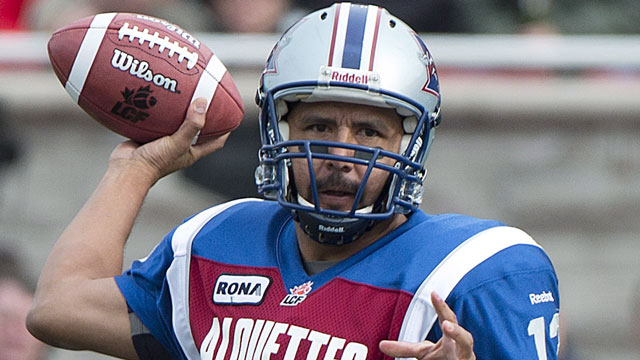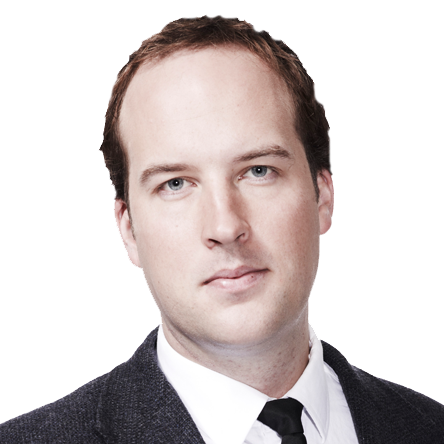In the last moments of his last game, Anthony Calvillo, one of the greatest CFL quarterbacks of all-time, did what he has so often done. He fired a football up the field, braced for impact and then fell to the ground. There was nothing vicious about the hit that brought him down, no head-on-head collision or twisting of limbs. And yet as the whistle blew, there was Calvillo: lying on his back and in pain for no apparent reason.
Sure he’d just been wrapped up and pulled to the ground by a 260-pound defensive end, but he’d gone down under a fraction of the force of previous hits. It seemed odd that Calvillo, a guy who’d missed just 22 games in the first 19 seasons of his career, could be so hurt by such an innocuous-looking tackle.
Brain injuries are often hard to spot, especially when their victims fail to lose consciousness. A guy gets knocked out cold and sports fans understand: that guy just got concussed. A legend gets pulled to the ground and starts complaining of some unseen agony and we sometimes misunderstand the significance.
Moments later, when he walked off the field with the help of two Montreal Alouettes support staff, it was clear Calvillo was in trouble. Soon people started to wonder if that failed reception and subsequent tackle were the sad, final moments of a storied career.
Now, eight weeks later, with Calvillo insistent on returning to the game, it raises the question of whether the future hall of famer should even bother. On Wednesday, Calvillo told reporters he planned to be in the Alouettes’ lineup for the last game of the regular season against the Toronto Argonauts on Nov. 1.
After 20 years, Calvillo has accomplished everything possible in the CFL and it’s entirely possible his career is best left finished by an otherwise insignificant hit on a Saskatchewan field.
If only he didn’t laugh to the media on Wednesday when presented with the very notion of retiring after that hit, it might be easier to empathize with a guy now eager to put his damaged head back into a helmet and take to the field. He’s been in the game a long time and has suffered enough concussions to understand that he has become increasingly susceptible to brain injury and the residual effects of post-concussion syndrome. He should, by now, understand that the headaches, dizziness and nausea he experienced after that hit in Saskatchewan are symptoms of brain damage.
He has absolutely nothing to prove and everything to lose in his return. Yet it’s troubling to know that his could be trumpeted as the heroic comeback of an aging warrior instead of the potentially self-destructive ending to an otherwise glorious career.
For four weeks after that hit in Saskatchewan, Calvillo reportedly couldn’t walk on a treadmill let alone throw a football without experiencing “symptoms” of post concussion syndrome. In his absence from the field, his team moved on, winning five of their next seven games, in their struggle to secure one of the last berths in the CFL post-season.
Now he says he’s symptom free, has been for three weeks and is able to walk on a treadmill, throw a ball and attend team meetings, taking notes, writing down plays and testing his short-term memory without issue. That’s great news, because he has a family and will eventually have a life after football and it’s nice to know his brain is still able to recover, albeit slowly. But in order to get back into game shape he’ll soon have to start lifting weights, running on that treadmill and taking a few hits to ensure he can withstand the demands of a grueling sport — all so that he can lead his team once more onto a gridiron.
He’s 41 years old, has three Grey Cups and a plethora of CFL records and he’s already earned his reputation as a warrior, on the field and off, having played through thyroid cancer.
Calvillo’s biggest problem isn’t his age or his increasing susceptibility to injury but rather his struggle with knowing when to quit. He says he has spent a lot of time asking himself whether he should retire the last few years. But he continues to come back. Whether it’s worth it this time only Calvillo can decide, but it doesn’t make it any less difficult to watch. The sad reality of his story is that it’s not unique. If it were, it might seem more heroic.
For every Ray Bourque, Alain Prost and David Robinson who retire as champions with a tear in their eye and a trophy in their hands there are thousands who are forced into retirement by age or injury. Muhammad Ali, Michael Jordan, Eric Lindros — they all stuck with their chosen sport for longer than they should have. Each paid a final toll: Jordan lost his game, Lindros his fearlessness and Ali his ability to talk.
If he walked away right now, Calvillo would leave football in the same way Doug Gilmour left hockey: with a legacy intact. Never mind that both men’s last professional moments were spent crawling on the ice or lying on the field.
There are few things more tragic in sport than watching a former great put it all on the line and get destroyed in the process. But here’s to Calvillo and the offensive linemen now charged with protecting his legacy — and his already damaged head.


